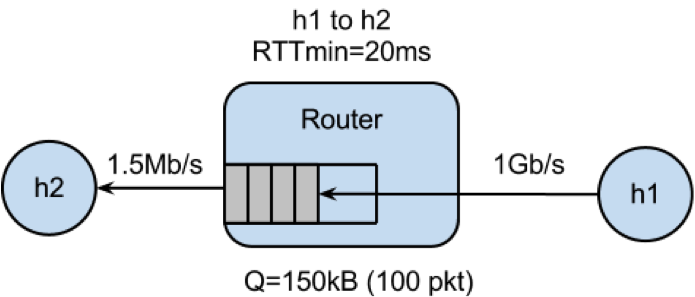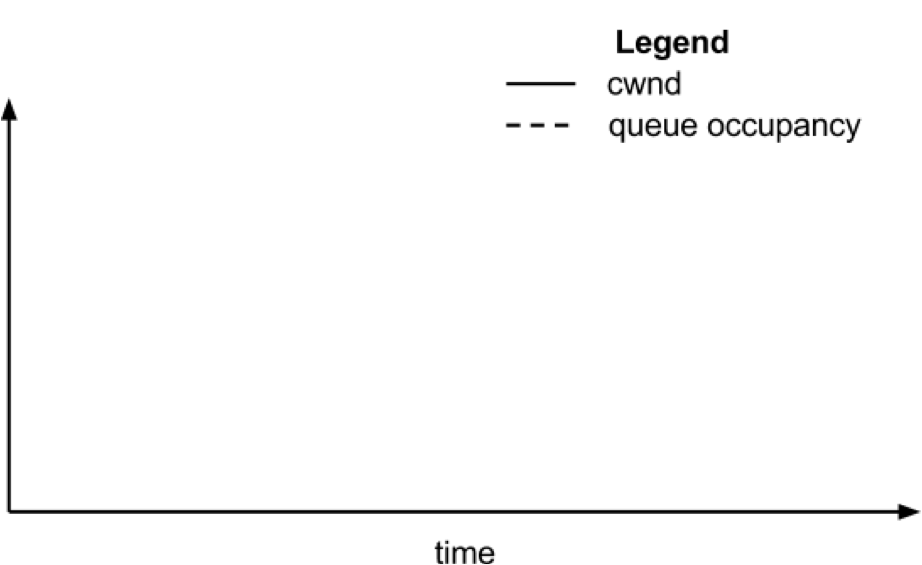-
Notifications
You must be signed in to change notification settings - Fork 1.7k
Bufferbloat
In this exercise we will study the dynamics of TCP in home networks. Take a look at the figure below which shows a “typical” home network with a Home Router connected to an end host. The Home Router is connected via Cable or DSL to a Headend router at the Internet access provider’s office. We are going to study what happens when we download data from a remote server to the End Host in this home network.

In a real network it’s hard to measure cwnd (because it’s private to the Server) and the buffer occupancy (because it’s private to the router). To make our measurement job easier, we are going to emulate the network in Mininet (See Environment Setup for setting up the environment).
The goals of the exercise are to:
- Learn first-hand the dynamics of cwnd and buffer occupancy in a “real” network.
- Learn why large router buffers can lead to poor performance in home networks. This problem is often called “Buffer Bloat.”
- Learn how to use Mininet so you can repeat or extend the experiments in your own time.

Bring up a terminal on your machine
> git clone https://bitbucket.org/huangty/cs144_bufferbloat.git
> cd cs144_bufferbloat/
> sudo ./run.sh
After Mininet is running, you can measure the delay from H1 to H2 with the command: mininet> h1 ping -c 10 h2
mininet> h2 wget http://10.0.0.1
Answer: _________________ seconds

To see how the dynamics of a long flow (which enters the AIMD phase) differs from a short flow (which never leaves slow-start), we are going to repeat Part 2 for a “streaming video flow”. Instead of actually watching videos on your machine, we are going to set up a long-lived high speed TCP connection instead, to emulate a long-lived video flow. You can generate long flows using the iperf command, and we have wrapped it in a script which you can run as follows:
mininet> h1 ./iperf.sh
You can see the throughput of TCP flow from H1 to H2 by running:
mininet> h2 tail -f ./iperf-recv.txt
You can quit viewing throughput by pressing CTRL-C.
Sketch how you think cwnd evolves over time at H1. You might find it useful to use ping to measure how the delay evolves over time, after the iperf has started:
mininet> h1 ping -c 100 h2

To see how our long-lived iperf flow affects our web page download, download the webpage again - while iperf is running. Write down how long it takes.
mininet> h2 wget http://10.0.0.1
Answer: _________________ seconds
Please write your explanation below. Answer:
It turns out that Mininet lets you measure cwnd and buffer occupancy values. A script is provided to dump the values of cwnd and buffer occupancy into files. We’re going to re-run a couple of the experiments and plot the real values.
Stop and restart Mininet and the monitor script, then re-run the above experiment as follows.
mininet> exit
bash$ sudo ./run.sh
In another bash terminal, go to cs144_bufferbloat directory and type the following giving a name for your experiment.
bash$ ./monitor.sh <EXP_NAME>
Don’t worry if you see “ERROR: Module tcp_probe does not exist in /proc/modules”, it just means this module is not previously loaded.
mininet> h1 ./iperf.sh
(wait for 70 seconds …)
mininet> h2 wget http://10.0.0.1
Wait for the wget to complete, then stop the python monitor script followed by the instructions on the screen. The cwnd values are saved in:
<EXP_NAME>_tcpprobe.txt and the buffer occupancy in <EXP_NAME>_sw0-qlen.txt.
Plot the TCP cwnd and queue occupancy from the output file
bash$ ./plot_figures.sh <EXP_NAME>
Adjust command line parameters to generate the figure you want.
The script will also host a webserver on the machine and you can use the url the script provided to access to your figures if it is a remote machine w/ public IP. Sample figures. If you are unable to see the cwnd, ensure you run wget after you started the monitor.sh script.
By now you will have realized that the buffer in the Headend router is so large that when it fills up with iperf packets, it delays the short wget flow. Next we’ll look at two ways to reduce the problem.
Stop any running Mininet and start Mininet again, but this time we will make the buffers 20 packets long instead:
bash$ sudo ./run-minq.sh
Let’s also run the monitor script on the side:
bash$ sudo ./monitor.sh <EXP_NAME>
mininet> h2 wget http://10.0.0.1
mininet> h1 ping -c 10 h2
mininet> h1 ./iperf.sh
mininet> h1 ping -c 30 h2
mininet> h2 wget http://10.0.0.1

Plot the figure for cwnd and queue occupancy, this time using the script “./plot_figures_minq.sh”
bash$ ./plot_figures_minq.sh
Then again, use the url to see your figures.Sample figures
Please put your explanation below. Answer:
The problem seems to be that packets from the short flow are stuck behind a lot of packets from the long flow. What if we maintain a separate queue for each flow and then put iperf and wget traffic into different queues?
For this experiment, we put the iperf and wget/ping packets into separate queues in the Headend router. The scheduler implements fair queueing so that when both queues are busy, each flow will receive half of the bottleneck link rate.

Start Mininet again, but this time we will create two queues, one for each type of traffic.
bash$ sudo ./run-diff.sh
mininet> h2 wget http://10.0.0.1
mininet> h1 ping -c 10 h2
mininet> h1 ./iperf.sh
mininet> h1 ping -c 30 h2
mininet> h2 wget http://10.0.0.1
You should see the ping delay (and the wget download time) doesn’t change much before and after we start the iperf.